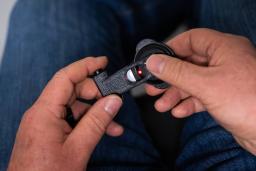HUS's new examination method shortened waiting times for wakefulness studies
Keywords:Currently over 70% of wakefulness studies are performed with the JOSLER method developed in HUS Clinical Neurophysiology. The growing prevalence of sleep apnea is increasing the demand for wakefulness studies.

The JOSLER method was implemented in August 2022, but its development in the Diagnostic Center’s Clinical Neurophysiology Unit began in 2018.
“The need for wakefulness studies had increased, so we needed to come up with solutions. We started to consider whether all patients needed an extensive wakefulness study or could there be a lighter version”, says Chief Medical Physicist Jaana Perkola.
The Maintenance of Wakefulness Test (MWT) that was being used is more demanding than the JOSLER examination and requires a nurse to attend to a single patient for an entire working day. With the JOSLER, one nurse can attend to two patients simultaneously. When compared to the JOSLER, analyzing and reporting the MWT results also take much more time from a physician.
The increased demand for tests started to limit their availability. The waiting time for a wakefulness study used to be four months. Now, the waiting time is 1–1.5 months and the availability of MWTs has increased significantly.
“This is a remarkable improvement. For example, professional drivers may need to be on sick leave the entire time they wait to get tested.”
EU legislation requires that professional drivers with sleep apnea are monitored in healthcare and their ability to drive is assessed. Professional drivers are the largest group of patients undergoing wakefulness studies, and sleep apnea is becoming more common amongst them.
With JOSLER, diagnosis is faster and the examination more comfortable
A wakefulness study is used to examine daytime alertness, abnormal daytime tiredness, and treatment effectiveness. A person’s alertness level may become decreased due to sleep apnea, for example. In sleep apnea, the patient’s airways become blocked occasionally during the night. This reduces the quality and amount of sleep. Sleep apnea is usually treated with CPAP, i.e., continuous positive airway pressure. The patient receives a CPAP device to take home and must use it every night.
JOSLER is a wakefulness study that is based on behavior. During the study, the patient sits in a dimly lit room holding a wireless response button. The patient needs to stay awake and press the button whenever a light blinks in it. If the patient fails to press the button seven times in a row, they are considered to have fallen asleep. If necessary, video can be used to check if the patient has dozed off. Patients will undergo three 40-minute testing sessions during a day. The method utilizes the Finnish Movesense wireless sensor.
“For patients, this new method means that they receive the necessary examination, diagnosis and treatment faster than before. The JOSLER examination is also more comfortable than the MWT”, explains Head Physician Anniina Norrkniivilä.
In the MWT, the patient undergoes four 40-minute testing sessions, and neurophysiological signals are used to monitor if the patient falls asleep. With some patients, it may be challenging to assess if the patient has fallen asleep during the MWT.
Reliable test results
The results from JOSLER studies have been compared with MWT results both in research performed by the Clinical Neurophysiology Unit and by other hospitals around the world with the previous similar OSLER device. Research shows that both methods yield equally reliable results.
The Clinical Neurophysiology Unit has provided 200 JOSLER examinations so far. At the same time, the number of MWTs has decreased.
The majority of patient feedback on JOSLER has been positive. “Even though the multi-session study can be heavy for patients with reduced alertness, patients find the JOSLER more comfortable than the MWT”, Dr. Norrkniivilä explains.
The Finnish Medicines Agency approved the JOSLER device in their register as an in-house device in May 2022. In 2023, JOSLER was implemented as the wakefulness study for professional drivers also at HUS Heart and Lung Center’s Sleep Apnea Outpatient Clinic.